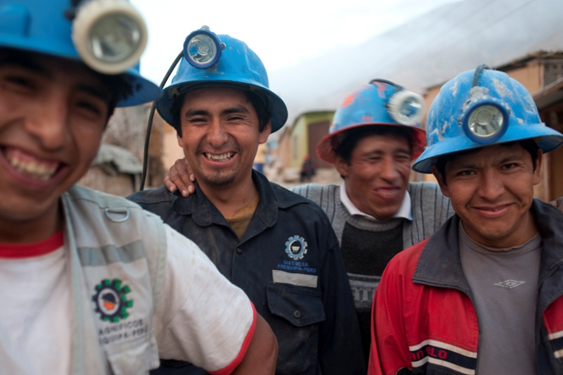Cooperative Miners that Produce Fairmined Gold/Photo by Red Social
The production of gold has been associated with egregious labor abuses, including forced and child labor, as well as violations of community land rights and environmental degradation. Small-scale miners often labor in hazardous conditions and harsh environments while earning wages below legal minimums, in some cases indebted to employers, moneylenders or other actors or being paid in kind for their work. The gold rush of recent years has attracted the attention of a diverse set of market actors, including not only multinational companies and small-scale or artisanal miners, but also criminal networks and other unscrupulous parties.
Verité is working to promote ethical labor practice in the gold sector through research that helps shed further light on the problem, and the development of tools and approaches that can build effective solutions.
Learn More
Verité’s research reveals that artisinal and small-scale mined (ASM) gold tainted by human rights abuses makes its way into the hands of global traders, refineries, banks and into our watches and smart phones. This research raises challenging questions for companies in industries including jewelry, mining, electronics, and banking.
Read more in these in-depth reports:
The Nexus of Illegal Gold Mining and Human Trafficking in Global Supply Chains (2016)
From the Field: Q&A with Quinn Kepes, lead researcher on this report
Worker Voices: Stories from the “Black Hole” of Illegal Gold
What Should Companies Do?
There is no easy solution to this problem; but, there are a number of important steps that companies can take to play their part in the solution. For more information, see:
Risks of Forced Labor in Illegal Gold Mining: Solutions for Companies
Recommendations from Case Study Research in Peru
Links to Verité’s Gold Research in the News:
Bloomberg News:
Willis, Andrew. “Colombia’s ‘Blood Gold’ Turns Up in Everything From Smartphones to Cars.” Bloomberg News. November 16, 2016.
The Guardian:
“Illegal mines and local mafia take shine off Latin American gold.” The Guardian. August 17, 2016.
Council on Hemispheric Affairs:
Boyd, Stephanie. “Who’s to Blame for Peru’s Gold-mining Troubles?” The New Yorker: Currency. October 28, 2013.
El Colombiano:
Escobar Roldán, Mariana. “Minería ilegal y crimen abonan terreno para el delito en América Latina.” El Colombiano. April 13, 2016.
Univision:
Reyes, Gerardo. “Los Nuevos Narcotesoros.” Univision. November 2014.
United States Department of State:
Kerry, John. “Remarks at Release of 2014 Trafficking in Persons Report.” U.S. Department of State. June 20, 2014.
International Business Times:
Jerin, Mathew. “Illegal Gold Exports From Peru to Decline due to Government Crackdown.” International Business Times. February 12, 2014.
New York Daily News:
Hastings, Deborah. “Held as slaves, children in Peru forced to work in mines that produce much of world’s gold.” New York Daily News. February 11, 2014.
In Sight Crime:
Wells, Miriam. How Gold Trade Fuels Modern-Day Slavery in Peru. In Sight Crime. February 10, 2014.
The New Yorker:
Boyd, Stephanie. “Who’s to Blame for Peru’s Gold-mining Troubles?” The New Yorker: Currency. October 28, 2013.
The Guardian:
Fraser, Barbara. “Tarnished gold: why Peru’s forced labor mining matters to the US.” The Guardian. October 16, 2013.
The Huffington Post:
Kepes, Quinn. “The Gold in Your Wedding Band: Mined by Modern-Day Slaves?” The Huffington Post. October 7, 2013.
El Comercio:
“El 20% de la producción nacional de oro proviene de la minería ilegal.” El Comercio. October 1, 2013.
